Key Takeaways
- It is important to maintain mobility, endurance, and strength as we age to stay healthy.
- It is recommended that older adults participate in 2.5 hours of moderate-intensity exercise, such as low-impact cardio workout and strength training, per week.
- Benefits of working out for older adults include fall prevention, improved quality of life, better mental health, and increased independence.
Especially with all the stigma about aging and exercise, starting an exercise routine as an adult in your 60s or later may feel intimidating or downright impossible. But in reality, exercising as an older adult is not only doable—it’s critical to maintain a high quality of life and independence.

In this guide to exercise for seniors, you’ll learn about the many benefits of physical activity for older adults, find a 20-minute workout with modification ideas, and hear from a certified personal trainer and a physical therapist about how to create safe and effective exercise protocols.
Benefits of Exercise for Seniors
The health benefits of exercise for older adults are profound. Here’s a look at what you can expect when you start exercising later in life. (It’s never too late!)
It Improves Cardiovascular Health
Cardio exercise, such as brisk walking, improves the health of your heart and blood vessels. Regular physical activity is linked to improved markers of cardiovascular health, such as lower blood pressure, resting heart rate, increased heart rate variability, and VO2 max. (1)(2)(3)
It Improves Bone Health
Weight-bearing exercise, including walking and resistance training, can slow the loss of bone mineral density. As people age, they typically lose bone mass, which ultimately can lead to osteoporosis and an increased risk of bone fractures. Research shows that weight-bearing exercise is one of the best ways to slow or reduce this bone mineral loss. (4)
It Increases Strength and Muscular Endurance
Resistance training increases muscular strength and muscular endurance—and yes, that’s true in older adults, too. For example, for seniors with sarcopenia (typically age-related muscle loss), strength training programs can improve strength and physical performance, although training may not have an effect on muscle mass. (5, 6)
It Helps With Fall Prevention and Functional Independence
Part of retaining functional independence later in life includes preventing falls. Luckily, exercise can help with that.
Physical activity strengthens the muscles and joints, improves balance and coordination, and increases proprioception (the knowledge of where one’s body is in space). All of these things help prevent falls and injuries, thus helping older adults remain able to take care of themselves and generally enjoy themselves. (7)
It Improves Mental Health and Quality of Life
A growing body of scientific evidence shows us that exercise may be just as effective, if not more so, than medical intervention for certain mental health conditions, including depression. In fact, exercise has been called a “first-choice treatment” for depressive disorders.
With regard to older adults specifically, researchers point to exercise as a “top theoretical treatment” for Alzheimer’s disease. A 2023 systematic review and meta-analysis calls exercise “conducive to mental health, preventing cognitive decline, depression, and anxiety symptoms” in older adults. (8)(9)(10)(11)
Exercise routines can encourage older people to participate in social groups, too, which may have a significant positive impact on daily life. In fact, “social fitness” is on the rise for this very reason: Exercising in groups adds to the already-profound benefits of physical activity. Its surge in popularity is a clear response to the growing loneliness epidemic in the U.S.
[Read More: How to Get Into CrossFit as an Older Adult]
Indeed, a 2023 study published in the Journal of Affective Disorders found that running clubs may be as effective at treating depression as therapy. In older people, having social support—i.e., exercising in groups—can increase motivation and adherence to exercise, according to a 2022 study in the International Journal of Environmental and Public Health. (12)(13)
And while water aerobics classes remain popular among older adults for their low-impact nature, there are certainly other options: Your local community center may offer other classes, like strength training, Tai Chi, yoga, Pilates, or dance fitness. Joining a neighborhood walking group is another way to get social and keep fit.
20-Minute Workout for Seniors
Looking for workout ideas as an older adult? This 20-minute workout covers all of the bases: cardio, strength, balance, and flexibility.
What You’ll Need
- An exercise mat, yoga mat, or cushion to place your hands and knees on
- A wall to press against for wall push-ups
- A light weight, such as a dumbbell or a full 16-ounce water bottle
The Workout
Complete the entire series three to five times. Rest as needed between movements.
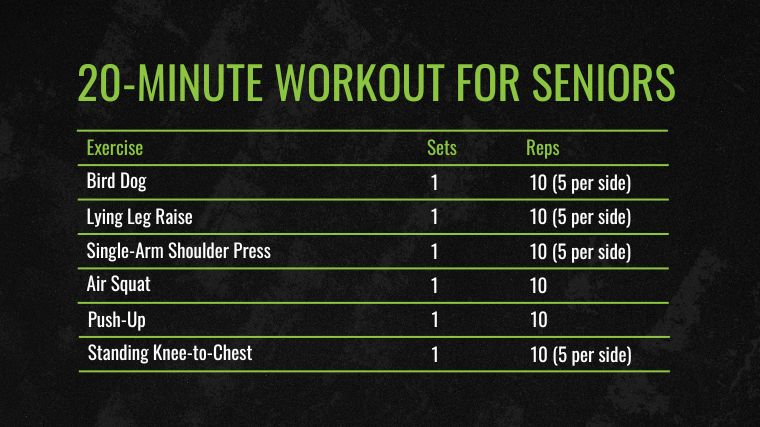
- Bird Dog: 10 repetitions (5 per side)
- Lying Leg Raise: 10 reps (5 per side)
- Single-Arm Shoulder Press: 10 reps (5 per side)
- Air Squat: 10 reps
- Push-Up: 10 reps
- Standing Knee-to-Chest: 10 reps (5 per side)
Don’t Forget to Warm Up
Before beginning the workout, make sure to warm up. Spend about five minutes doing a general warm-up to get your heart rate up and increase blood flow: Walk around your house or march in place.
After five minutes, perform this series of warm-up exercises three times:
- Arm Circles Forward: 15 seconds
- Arm Circles Backward: 15 seconds
- Seated Marching: 30 seconds
- Seated Calf Raise: 30 seconds
Sit upright in a chair with your feet flat and knees bent; lift one leg upward while keeping your knees bent and alternate.
Sit upright in a chair with your feet flat and knees bent; press your toes into the ground and lift your heels up while remaining seated.
Now you’re ready for the workout.
Bird Dog
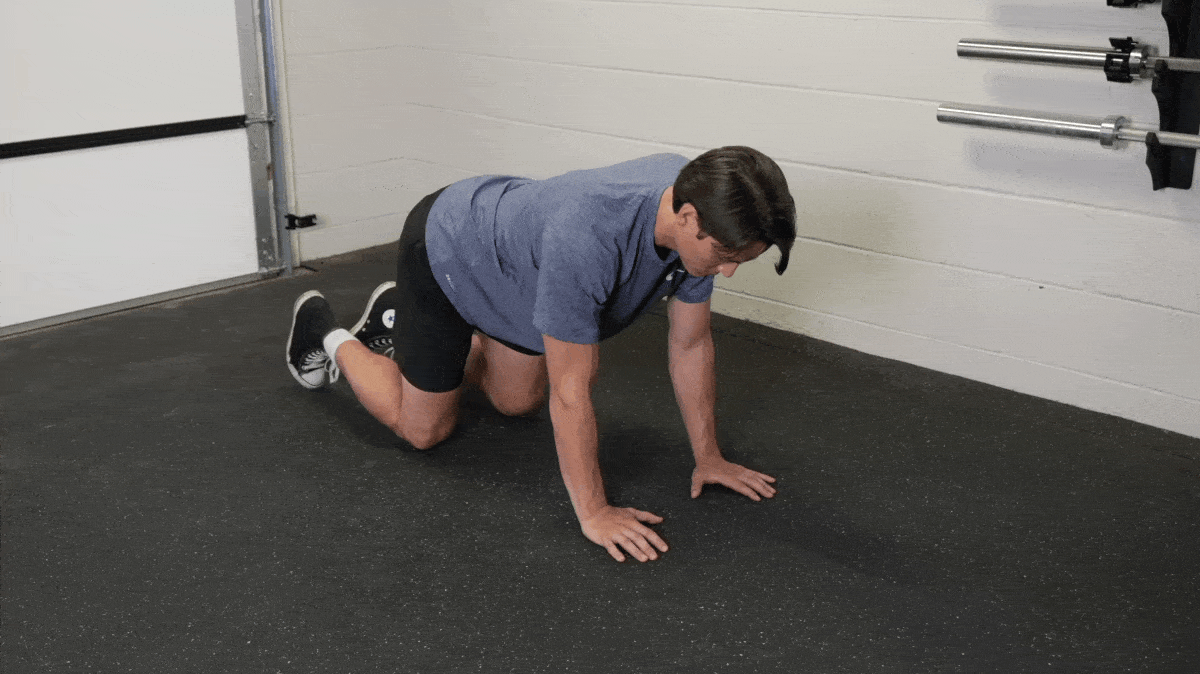
| Equipment Needed | Yoga mat/exercise mat/cushion for knees |
| Muscles Worked | Core, glutes, shoulders, upper back |
| Sets & Reps | 5 reps on each side during each round of the workout |
The bird dog is an ideal exercise for developing core stability and strength while also promoting balance and coordination. It’s a great strengthening exercise for the glutes, too.
How to Do It:
- Start on all fours on your exercise mat, with your hips stacked above your knees and shoulders stacked above your wrists. Keep your neck straight and your gaze down: Don’t crane your neck. Maintain a flat spine.
- Slowly lift your right leg and your left arm simultaneously until they form straight lines outward from your torso.
- Gently lower your arm and leg back to the mat, then lift your left leg and right arm.
- Alternate until you complete the rep count.
Modifications
- Make it Easier: Instead of lifting your arm and leg simultaneously, keep both arms planted and lift just your leg.
- Make it Harder: Hold the position at the top for a count of three before lowering your arm and leg back to the mat.
Lying Leg Raise
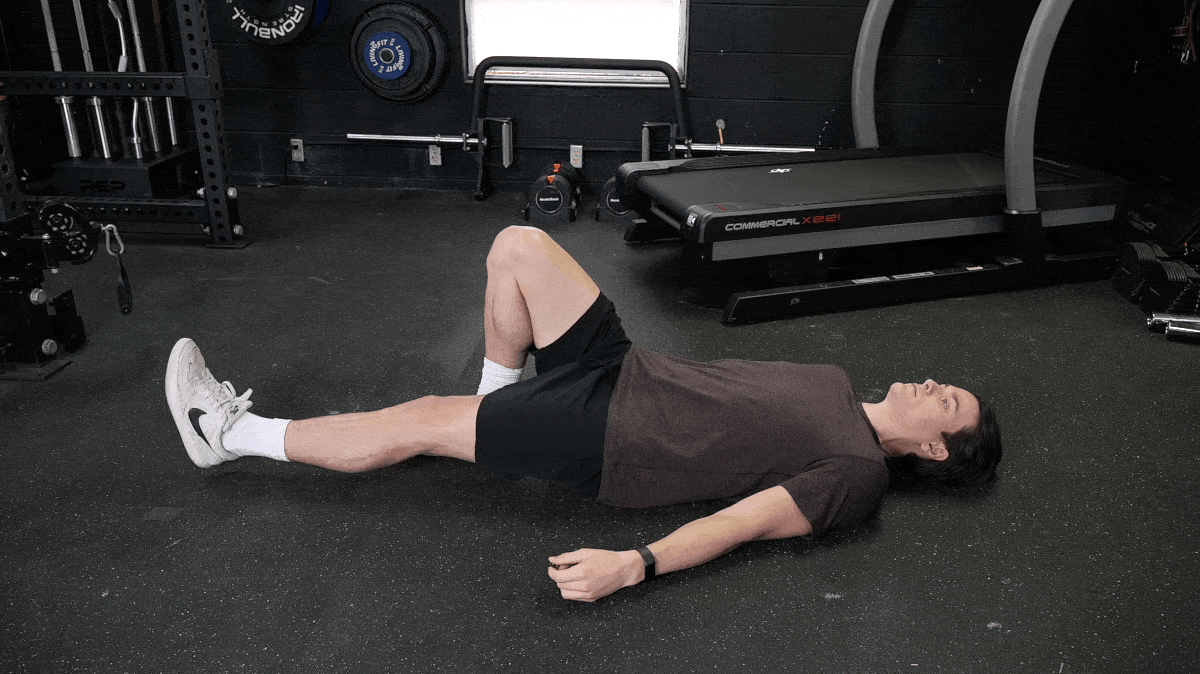
| Equipment Needed | Yoga mat/exercise mat |
| Muscles Worked | Glutes, hip abductors |
| Sets & Reps | 5 reps on each side during each round of the workout |
This simple exercise packs a strengthening punch for the lower body. It targets the hip abductors, muscles that play a big role in balance and healthy hips.
How to Do It:
- Lie on your right side on your exercise mat, with your hips stacked above one another. (Don’t twist your spine.) You may use your right arm to support your neck and head.
- Lift your left leg straight upward as high as you can, noticing your glutes working.
- Lower your leg back down. Complete the rep count, and then switch sides.
Modifications
- Make it Easier: Reduce the range of motion (i.e., don’t force yourself to lift your leg higher) until you gain more strength and flexibility.
- Make it Harder: Add an element of resistance, such as a small dumbbell held at your hip or a light resistance band around the knees.
Single-Arm Shoulder Press
[Read More: The Best Adjustable Dumbbells for Your Home Gym]
| Equipment Needed | Dumbbell |
| Muscles Worked | Shoulders, core |
| Sets & Reps | 5 reps on each side during each round of the workout |
Our shoulders do so much for us: They help us pick things up, move objects around, place items on shelves, open doors, and so much more. The single-arm shoulder press not only strengthens your shoulder muscles but also promotes core stability and balance.
How to Do It:
- Stand up straight with your feet about shoulder-width apart, holding your dumbbell at your side.
- Bring the dumbbell to shoulder height, keeping your elbow bent.
- Press the weight overhead until your elbow is almost fully extended (careful not to overextend).
- Lower the weight back to shoulder height carefully.
- Repeat until you complete the rep count, and then switch sides.
Modifications
- Make it Easier: Try the seated version of this exercise. In a chair with your feet flat on the ground and knees bent, practice the single-arm press until you develop the required core stability and balance to perform it standing up.
- Make it Harder: Increase the weight or rep count as you get stronger.
Air Squat
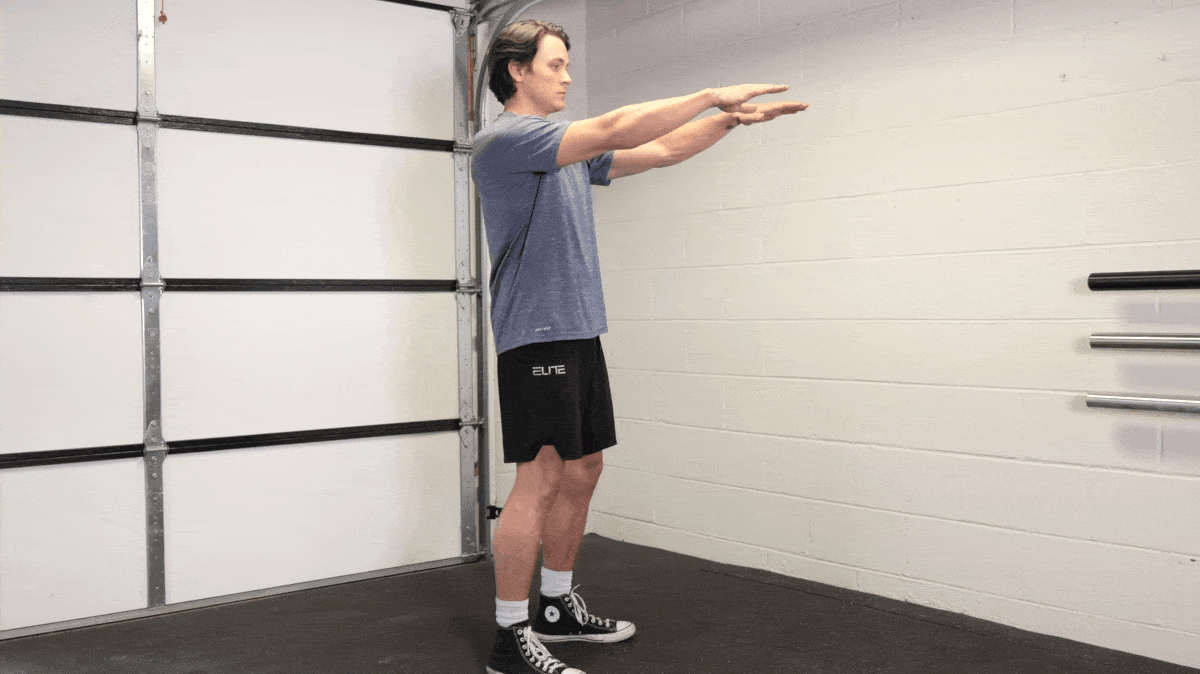
| Equipment Needed | Something to hold onto for assisted squats (if needed), such as a TRX, pole/post, or very sturdy piece of furniture |
| Muscles Worked | Quads, hamstrings, glutes |
| Sets & Reps | 10 reps during each round of the workout |
Squats are one of the most functional exercises you can do. We utilize this movement pattern when sitting down for dinner, getting into our cars, picking things up (properly) from the ground, and in many other scenarios. It strengthens the lower body and promotes a strong core.
How to Do It:
- Stand up with your feet about hip-width apart and your feet planted firmly.
- Hinge backward at the hips and bend your knees to begin lowering yourself into a squat.
- Descend until you reach the lowest point you can without raising your heels up from the ground or dropping your chest toward the floor.
- Ascend to the starting position. Repeat until you complete all reps.
Modifications
- Make it Easier: Squat to a chair for guidance, or use an apparatus for assistance, such as a post/pole, suspension system (like a TRX), or a very sturdy piece of furniture (e.g., the back of your sofa).
- Make it Harder: Challenge yourself to deepen your squat if the mobility is there. You can also add weight.
Push-Up
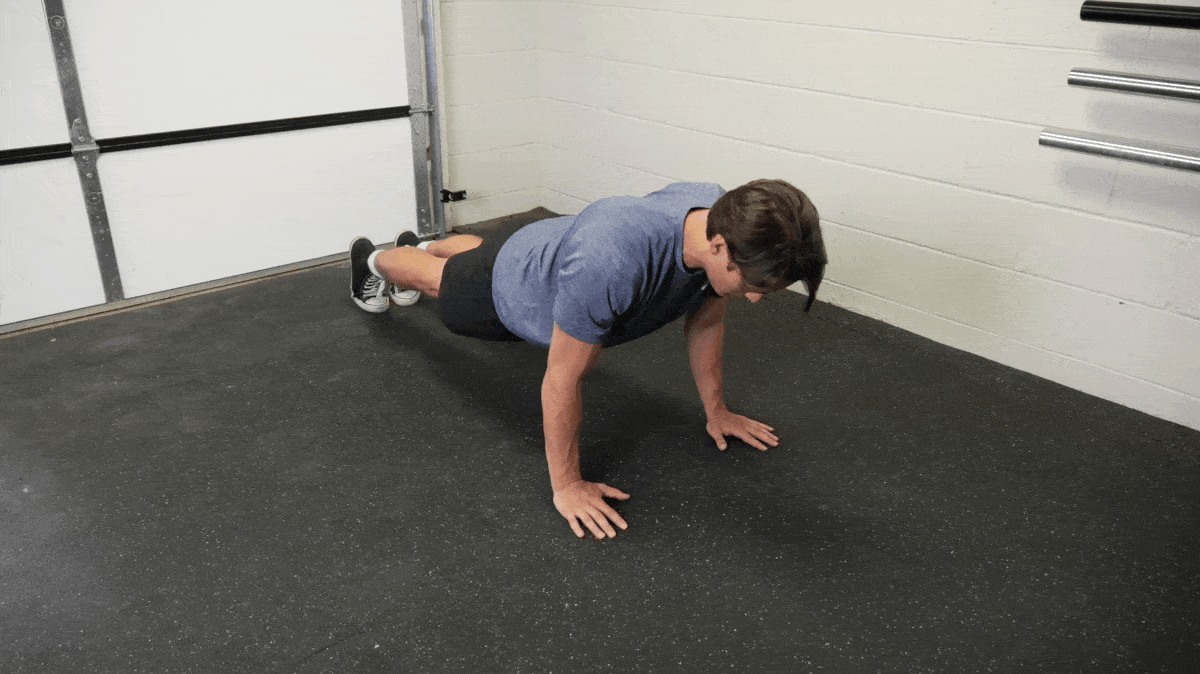
| Equipment Needed | A wall or elevated surface for assisted push-ups and an exercise or yoga mat |
| Muscles Worked | Shoulders, chest, core, triceps |
| Sets & Reps | 10 reps during each round of the workout |
An effective bodyweight exercise, push-ups strengthen the chest and shoulders while challenging the core.
How to Do It:
- Get on all fours on your exercise mat. Stack your hips above your knees and your shoulders above your wrists.
- Extend your knees so that you are balanced on your hands and toes (plank position).
- Bend your elbows to lower your body toward the ground. Your chest and hips should move together in one clean line.
- Press back up to the plank position.
- Repeat until you complete the rep count.
Modifications
- Make it Easier: Perform push-ups on your knees to offset the resistance, or use an elevated surface to make them easier. Wall push-ups are a great beginner option.
- Make it Harder: Take it slow. Instead of rushing through the reps, slow down the descent and pause in the bottom and top positions for one second.
Standing Knee-to-Chest
| Equipment Needed | A chair for a modified version, or something else stable to hold onto for balance |
| Muscles Worked | Hip flexors, glutes, core |
| Sets & Reps | 5 reps on each side during each round of the workout |
This exercise promotes balance and flexibility while strengthening the quadriceps and hip flexors, and it’s easy to modify to make it easier or more challenging.
How to Do It:
- Stand up tall with your feet about hip-width apart, with your feet planted firmly.
- Keeping your knee bent, lift your left leg up as high as you can without losing your balance.
- Pause for one second; then gently lower your left leg back to the ground.
- Repeat with your right leg. Continue alternating until you complete all reps.
Modifications
- Make it Easier: Perform this move seated in a chair if you do not yet have the balance to perform it standing. You can also hold onto furniture, a wall, or a post for help with balance while standing.
- Make it Harder: Hug your knee to your chest for a deeper stretch and a bigger challenge to your balance.
How to Program Exercises for Seniors
Whether you are a personal trainer searching for ideas about how to program effective exercise for older adults or an older person learning how to program for yourself, these tips from a fitness trainer and physical therapist can help.
Integrate Medical Requirements
Certified personal trainer James Cunningham, BSc in Sport and Exercise Science, says it’s critical to gather a complete medical history before beginning an exercise protocol—for anyone, not just seniors.
“I always encourage participants to consult with their doctors before starting any new fitness regimen, and I make a point of staying informed about their medical history, including any medications or treatments they may be undergoing,” he says. “This allows me to tailor workouts to accommodate any specific limitations or contraindications while still providing effective and safe exercise options.”
For example, individuals with age-related conditions such as arthritis, may need specific customizations to achieve the intended stimulus of the workout without undue pain. Plans for those with osteoporosis should include an emphasis on weight-bearing exercise, which is proven to slow down bone mineral loss.
[Read More: The Benefits of CrossFit for People Age 60 and Above]
For people who have heart disease, including high blood pressure, precautions should be taken as directed by the medical advice of the client’s provider.
“By working collaboratively with healthcare providers and prioritizing participant safety and well-being, participants receive the most beneficial and appropriate workouts for their individual needs,” Cunningham says.
Strength Training is Key—And So Are Modifications
Strength training exercises, whether performed with one’s body weight, dumbbells, or resistance bands, are beneficial for older adults. The research is clear: Resistance training is key to healthy aging, with studies suggesting it can help combat sarcopenia, osteoarthritis, and osteoporosis. (14)(15)(16)
That said, trainers should take caution and make modifications where necessary. Physical therapist Renee Roth Powers says that “protecting joints is a first-line concern.”
“Overly repetitive strength or weightlifting exercises can create too much compression in aging joints,” she explains. “The key to adapting is to not overload with resistance and not overdo it with multi-joint exercises like squats, lunges, or overhead press if someone has a cranky hip, knee, shoulder, back, or neck.”
[Read More: The Best Rowing Machines for Seniors]
Powers encourages trainers to help older adults build strength gradually as the tendons, ligaments, and other tissues adjust to new movements and new loads. She points out that, “Older patients heal much more slowly, no matter how amazingly fit they are. It’s much better to go very slowly than to have to recover from an injury due to exercising.”
For older adults with mobility limitations, lower back pain, or balance that needs improving, chair exercises may come into play. Seated exercises allow athletes to work on building up their strength while minimizing the risk of pain, injury, or a fall.
Integrate Low-Impact Cardio
Cunningham says he typically opts for low-impact cardio exercises with older clients. “Low-impact exercises, such as swimming, cycling, or using elliptical machines, reduce stress on the joints while still providing effective cardiovascular workouts,” he says. The idea is to get the heart rate up and exercise at a moderate intensity without placing undue stress on the joints.
A Focus on Flexibility
“All older adult activity should be monitored for relative flexibility,” says Powers. “That means if one joint or muscle group is stiff, [find out] what region gives too much to compensate for that stiffness.”
“For instance, if the hips don’t bend well, which is very common, often the upper back will bend far too much and will experience strain trying to reach the toes,” she explains. Customizations and modifications are critical here, she says, and in this case, “The key is to bend the knees a little, let the hips bend if possible, and keep the upper back flat.”
[Read More: Chinese Seniors Are Throwing Stones Around Like Kettlebells to Stay In Shape]
In addition to knowing the cause of any stiffness, it’s important to “know if an older person is stretching tight muscle tissue or forcing a resistant joint to a position that it will no longer move into,” Powers says.
For example, “If a 70-year-old person has a stiff hip due to osteoarthritis, ‘stretching’ that hip in certain ways could further grind and degenerate the bones, increasing pain and mobility challenges.” In this case, a knee-to-chest stretch (single plane of motion) is preferred over a figure-four stretch, “which twists and pulls the hip in multiple planes,” Powers explains.
Include Balance Exercises
Fall prevention is a cornerstone of exercise programming for older adults. Examples of balance exercises include: marching in place, single-leg stands, and heel-to-toe walks. Tai Chi, yoga, Qigong, and Pilates, are all forms of exercise that encourage balance.
[Read More: Get a Leg Up On Your Training With These Exercises for Balance & Stability]
One way to remember to incorporate balance exercises is to include them in your cool-down after every training session. Just five or 10 minutes of balance training a few times per week can make a significant difference in how your body moves in daily life—making everyday chores and activities safer and more enjoyable.
(Safely) Prioritize Progressive Overload
Progressive overload is a foundational principle of fitness training. It refers to the process of continually increasing the challenge placed on your musculoskeletal or cardiovascular system in order to promote continued adaptation—AKA increased fitness.
This foundational concept doesn’t go away with age. Even later in life, it’s important to continue to improve one’s fitness. However, additional precautions may be necessary.

[Read More: How to Start Olympic Weightlifting After 50]
While young fitness enthusiasts may be quick to hop on the latest functional fitness trend, Powers says, “The older population is generally not a group to try the latest dynamic exercise circulating on TikTok—tried-and-true exercises are typically best. That means there may be two or three standard exercises for someone who has a knee or hip issue, and that’s OK.”
CPT Cunningham echoes this sentiment, saying it’s important to “prioritize proper form and technique over heavy weights or high-intensity trainings, ensuring that each movement is performed correctly to reduce the likelihood of injury.”
Assess and Track
Any good exercise program begins with a series of assessments. An experienced and knowledgeable personal trainer will assess your strength, balance, flexibility, mobility, and cardiovascular fitness to understand where you’re starting from.
“When someone begins training with me, I conduct a thorough initial assessment that includes measurements, range of motion tests, balance assessments, and discussions about their health history, goals, and any limitations or concerns they may have,” Cunningham says. “This provides me with a baseline understanding of their current fitness level and helps me tailor a program that meets their individual needs.”
The initial battery of tests is also important for tracking purposes—it helps you see how far you’ve come over a period of weeks, months, or years.
[Read More: The Best Treadmills for Seniors]
To track progress over time, Cunningham says he uses a combination of objective measurements, such as strength gains or improvements in flexibility, and subjective feedback from participants about how they’re feeling and what changes they’ve noticed in their overall health and well-being.
“Regular check-ins and reassessments allow me to adjust their workouts as needed and ensure they continue to make progress towards their goals,” he explains.
Frequently Asked Questions
It’s natural to have a lot of questions about exercising as an older adult. Here are the ones we hear most often.
What is the best form of exercise for seniors?
Some of the best exercises for older people include low-impact cardio and resistance training. James Cunningham, certified personal trainer, says using resistance bands, light dumbbells, and bodyweight exercises are ideal for older adults as they build up strength.
How much physical activity do older adults need?
Older adults should aim to meet the minimum recommendation from the Physical Activity Guidelines for Americans: 150 minutes of moderate-intensity cardio exercise and two sessions of muscle-strengthening exercise per week. There are a lot of ways to achieve this, but here’s one example: five 30-minute walks, one upper-body strength workout, and one lower-body strength workout per week.
What exercise should a 70-year-old be doing?
A 70-year-old adult should prioritize exercises that promote functional independence and healthy aging. This includes strength training, cardiovascular exercise, and balance and flexibility exercises.
Strength training can be done with free weights, machines, resistance bands, or one’s body weight. Cardio options include walking, hiking, cycling, swimming, dance, water aerobics, or elliptical training. For balance and flexibility, try Tai Chi, Qigong, yoga, Pilates, or simple stretching routines.
Editor’s Note: The content on BarBend is meant to be informative in nature, but it should not be taken as medical advice. When starting a new training regimen and/or diet, it is always a good idea to consult with a trusted medical professional. We are not a medical resource. The opinions and articles on this site are not intended for use as diagnosis, prevention, and/or treatment of health problems. They are not substitutes for consulting a qualified medical professional.
References
- Sant’Ana LO, Machado S, Ribeiro AAS, et al. Effects of Cardiovascular Interval Training in Healthy Elderly Subjects: A Systematic Review. Front Physiol. 2020;11:739.
- Liew JM, Teo SP. Physical activity in older people with cardiac co-morbidities. J Geriatr Cardiol. 2018;15(8):557-558.
- Ciumărnean L, Milaciu MV, Negrean V, et al. Cardiovascular Risk Factors and Physical Activity for the Prevention of Cardiovascular Diseases in the Elderly. Int J Environ Res Public Health. 2021;19(1):207.
- Zhang L, Zheng YL, Wang R, Wang XQ, Zhang H. Exercise for osteoporosis: A literature review of pathology and mechanism. Front Immunol. 2022;13:1005665.
- Bao W, Sun Y, Zhang T, et al. Exercise Programs for Muscle Mass, Muscle Strength and Physical Performance in Older Adults with Sarcopenia: A Systematic Review and Meta-Analysis. Aging Dis. 2020;11(4):863-873.
- Wang H, Huang WY, Zhao Y. Efficacy of Exercise on Muscle Function and Physical Performance in Older Adults with Sarcopenia: An Updated Systematic Review and Meta-Analysis. Int J Environ Res Public Health. 2022;19(13):8212.
- Shin S, Wuensche B. What type of exercises should older adults engage in to improve fall efficacy and physical fitness related to falling?. J Exerc Rehabil. 2023;19(4):198-207.
- Heissel A, Heinen D, Brokmeier LL, et alExercise as medicine for depressive symptoms? A systematic review and meta-analysis with meta-regressionBritish Journal of Sports Medicine 2023;57:1049-1057.
- Singh B, Olds T, Curtis R, et alEffectiveness of physical activity interventions for improving depression, anxiety and distress: an overview of systematic reviewsBritish Journal of Sports Medicine 2023;57:1203-1209.
- Hill, M.A., Gammie, S.C. Alzheimer’s disease large-scale gene expression portrait identifies exercise as the top theoretical treatment. Sci Rep 12, 17189 (2022).
- Xu L, Gu H, Cai X, et al. The Effects of Exercise for Cognitive Function in Older Adults: A Systematic Review and Meta-Analysis of Randomized Controlled Trials. Int J Environ Res Public Health. 2023;20(2):1088.
- Verhoeven JE, Han LKM, Lever-van Milligen BA, et al. Antidepressants or running therapy: Comparing effects on mental and physical health in patients with depression and anxiety disorders. J Affect Disord. 2023;329:19-29.
- Huang WY, Huang H, Wu CE. Physical Activity and Social Support to Promote a Health-Promoting Lifestyle in Older Adults: An Intervention Study. Int J Environ Res Public Health. 2022;19(21):14382.
- Zhao H, Cheng R, Song G, et al. The Effect of Resistance Training on the Rehabilitation of Elderly Patients with Sarcopenia: A Meta-Analysis. Int J Environ Res Public Health. 2022;19(23):15491.
- Latham N, Liu CJ. Strength training in older adults: the benefits for osteoarthritis. Clin Geriatr Med. 2010;26(3):445-459.
- Holubiac IȘ, Leuciuc FV, Crăciun DM, Dobrescu T. Effect of Strength Training Protocol on Bone Mineral Density for Postmenopausal Women with Osteopenia/Osteoporosis Assessed by Dual-Energy X-ray Absorptiometry (DEXA). Sensors (Basel). 2022;22(5):1904.
Featured Image: PeopleImages.com – Yuri A / Shutterstock